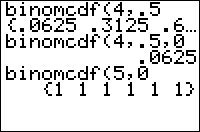TI-BASIC:Binomcdf: Difference between revisions
Initial automated import |
KermMartian (talk | contribs) No edit summary |
||
| Line 90: | Line 90: | ||
Since "at most N" is equivalent to "0 or 1 or 2 or 3 or ... N", and since we can combine these probabilities by adding them, we can come up with an expression for binomcdf( by adding up values of [[TI-BASIC:Binompdf|Binompdf(]]: | Since "at most N" is equivalent to "0 or 1 or 2 or 3 or ... N", and since we can combine these probabilities by adding them, we can come up with an expression for binomcdf( by adding up values of [[TI-BASIC:Binompdf|Binompdf(]]: | ||
<math> | |||
\operatorname{binomcdf}(n,p,k) = \sum_{i=0}^{k}\operatorname{binompdf}(n,p,i) = \sum_{i=0}^{k}\binom{n}{i}\,p^i\,(1-p)^{n-i} | \operatorname{binomcdf}(n,p,k) = \sum_{i=0}^{k}\operatorname{binompdf}(n,p,i) = \sum_{i=0}^{k}\binom{n}{i}\,p^i\,(1-p)^{n-i} | ||
</math> | |||
(If you're not familiar with sigma notation, <math>\sum_{i=0}^{k}</math> just means "add the following up for each value of i 0 through k") | (If you're not familiar with sigma notation, <math>\sum_{i=0}^{k}</math> just means "add the following up for each value of i 0 through k") | ||
Revision as of 19:25, 24 February 2016
Command Summary
Calculates the binomial cumulative probability, either at a single value or for all values
Command Syntax
for a single value: binomcdf(trials, probability, value
for a list of all values (0 to trials) binomcdf(trials, probability
Menu Location
Press:
- 2ND DISTR to access the distribution menu
- ALPHA A to select binomcdf(, or use arrows.
Press ALPHA B instead of ALPHA A on a TI-84+/SE with OS 2.30 or higher.
TI-83/84/+/SE
2 bytes
This command is used to calculate the binomial cumulative probability function. In plainer language, it solves a specific type of often-encountered probability problem, that occurs under the following conditions:
- A specific event has only two outcomes, which we will call "success" and "failure"
- This event is going to repeat a specific number of times, or "trials"
- Success or failure is determined randomly with the same probability of success each time the event occurs
- We're interested in the probability that there are at most N successes
For example, consider a couple that intends to have 4 children. What is the probability that at most 2 are girls?
- The event here is a child being born. It has two outcomes "boy" or "girl". In this case, since the question is about girls, it's easier to call "girl" a success.
- The event is going to repeat 4 times, so we have 4 trials
- The probability of a girl being born is 50% or 1/2 each time
- We're interested in the probability that there are at most 2 successes (2 girls)
The syntax here is binomcdf(trials, probability, value). In this case:
:binomcdf(4,.5,2
This will give .6875 when you run it, so there's a .6875 probability out of 4 children, at most 2 will be girls.
An alternate syntax for binomcdf( leaves off the last argument, value. This tells the calculator to compute a list of the results for all values. For example:
:binomcdf(4,.5
This will come to {.0625 .3125 .6875 .9375 1} when you run it. These are all the probabilities we get when you replace "at most 2 girls" with "at most 0", "at most 1", etc. Here, .0625 is the probability of "at most 0" girls (or just 0 girls), .3125 is the probability of at most 1 girl (1 or 0 girls), etc.
Several other probability problems actually are the same as this one. For example, "less than N" girls, just means "at most N-1" girls. "At least N" girls means "at most (total-N)" boys (here we switch our definition of what a success is). "No more than", of course, means the same as "at most".
Advanced (for programmers)
The Binompdf( and binomcdf( commands are the only ones apart from seq( that can return a list of a given length, and they do it much more quickly. It therefore makes sense, in some situations, to use these commands as substitutes for seq(.
Here's how to do it:
- cumSum(binomcdf(N,0 gives the list {1 2 ... N+1}, and cumSum(not(binompdf(N,0 gives the list {0 1 2 ... N}.
- With seq(, you normally do math inside the list: seq(3I^^2^^,I,0,5
- With these commands, you do the same math outside the list: 3Ans^^2^^ where Ans is the list {0 1 ... 5}.
:seq(2^I,I,1,5 can be :cumSum(binomcdf(4,0 :2^Ans which in turn can be :2^cumSum(binomcdf(4,0
In general (where f() is some operation or even several operations):
:seq(f(I),I,1,N can be :cumSum(binomcdf(N-1,0 :f(Ans which can sometimes be :f(cumSum(binomcdf(N-1,0
If the lower bound on I in the seq( statement is 0 and not 1, you can use binompdf( instead:
:seq(f(I),I,0,N can be :cumSum(not(binompdf(N,0 :f(Ans which can sometimes be :f(cumSum(not(binompdf(N,0
This will not work if some command inside seq( can take only a number and not a list as an argument. For example, seq(L,,1,,(I),I,1,5 cannot be optimized this way.
Formulas
Since "at most N" is equivalent to "0 or 1 or 2 or 3 or ... N", and since we can combine these probabilities by adding them, we can come up with an expression for binomcdf( by adding up values of Binompdf(:
<math> \operatorname{binomcdf}(n,p,k) = \sum_{i=0}^{k}\operatorname{binompdf}(n,p,i) = \sum_{i=0}^{k}\binom{n}{i}\,p^i\,(1-p)^{n-i} </math>
(If you're not familiar with sigma notation, <math>\sum_{i=0}^{k}</math> just means "add the following up for each value of i 0 through k")
Error Conditions
- ERR:DATATYPE is thrown if you try to generate a list of probabilities with p equal to 0 or 1, and at least 257 trials.
- ERR:DOMAIN is thrown if the number of trials is at least 1 000 000, unless the other arguments make the problem trivial.
